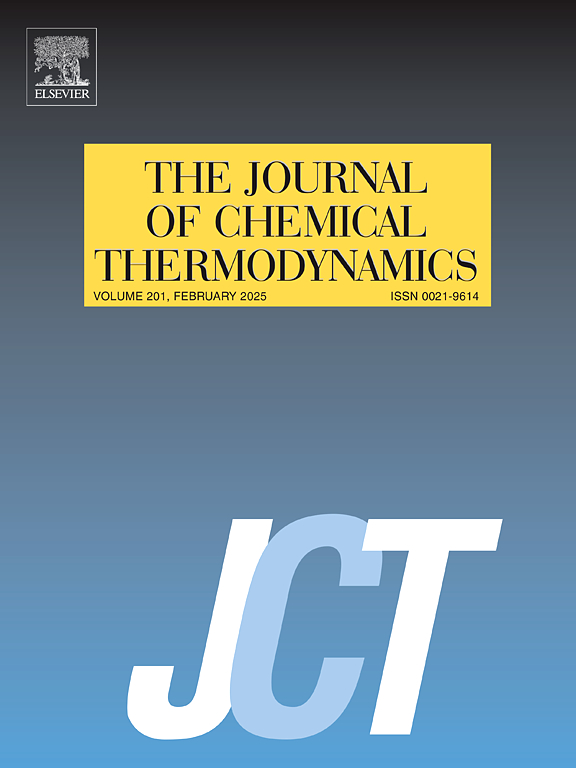CO2 +十六烷+丁基环己烷体系的高压相平衡和体积性质:实验和模拟研究
IF 2.2
3区 工程技术
Q3 CHEMISTRY, PHYSICAL
引用次数: 0
摘要
采用变体积高压观察池,研究了两种十六烷+丁基环己烷混合物在加入二氧化碳的情况下的相平衡。在5种不同的温度条件下,研究了5个二氧化碳浓度从13%到85%不等的等层。此外,在五种温度和压力下,获得了三种不同的十六烷+丁基环己烷混合物的高压密度数据,最高压力为100 MPa。将经典的Peng-Robinson状态方程(PR EoS)与包含温度相关二元相互作用参数(kij)的完全预测混合规则应用于实验测量的相平衡模型。这两种三元混合物在所有研究的整体成分中都表现出经典行为,仅表现出简单的液-气平衡。PR - EoS方法定性地捕获了两个系统的实验相位行为。利用Tammann-Tait方程对实验密度数据进行关联,计算等温压缩系数(κT)、等温热膨胀系数(αP)、热压系数(γv)和内压(Pi)等热力学导数性质。本文章由计算机程序翻译,如有差异,请以英文原文为准。

High-pressure phase equilibria and volumetric properties of the CO2 + hexadecane + butylcyclohexane system: Experimental and modeling study
The phase equilibria of two hexadecane + butylcyclohexane mixtures were investigated by adding carbon dioxide, for which no data are available in the literature, using a variable-volume high-pressure view cell. Five isopleths ranging from 13 to 85 mol% carbon dioxide were studied at five different temperature conditions. In addition, high-pressure density data were obtained for three different hexadecane + butylcyclohexane mixtures at five temperatures and pressures up to 100 MPa. The classical Peng-Robinson equation of state (PR EoS) was applied with a fully predictive mixing rule incorporating a temperature-dependent binary interaction parameter () to model the experimentally measured phase equilibria. The two ternary mixtures exhibited classical behavior across all global compositions investigated, presenting only simple liquid-vapor equilibrium. The PR EoS approach qualitatively captured the experimental phase behavior of both systems. Moreover, the experimental density data were correlated using the Tammann–Tait equation, and the following thermodynamic derivative properties were calculated: isothermal compressibility (), isobaric thermal expansivity (, thermal pressure coefficient (), and internal pressure ().
求助全文
通过发布文献求助,成功后即可免费获取论文全文。
去求助
来源期刊

Journal of Chemical Thermodynamics
工程技术-热力学
CiteScore
5.60
自引率
15.40%
发文量
199
审稿时长
79 days
期刊介绍:
The Journal of Chemical Thermodynamics exists primarily for dissemination of significant new knowledge in experimental equilibrium thermodynamics and transport properties of chemical systems. The defining attributes of The Journal are the quality and relevance of the papers published.
The Journal publishes work relating to gases, liquids, solids, polymers, mixtures, solutions and interfaces. Studies on systems with variability, such as biological or bio-based materials, gas hydrates, among others, will also be considered provided these are well characterized and reproducible where possible. Experimental methods should be described in sufficient detail to allow critical assessment of the accuracy claimed.
Authors are encouraged to provide physical or chemical interpretations of the results. Articles can contain modelling sections providing representations of data or molecular insights into the properties or transformations studied. Theoretical papers on chemical thermodynamics using molecular theory or modelling are also considered.
The Journal welcomes review articles in the field of chemical thermodynamics but prospective authors should first consult one of the Editors concerning the suitability of the proposed review.
Contributions of a routine nature or reporting on uncharacterised materials are not accepted.
 求助内容:
求助内容: 应助结果提醒方式:
应助结果提醒方式:


